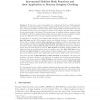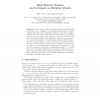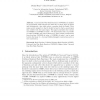ICALP
2010
Springer
14 years 11 months ago
2010
Springer
We show that linear probing requires 5-independent hash functions for expected constant-time performance, matching an upper bound of [Pagh et al. STOC’07]. For (1 + ε)-approxima...
FSE
2010
Springer
14 years 11 months ago
2010
Springer
We answer the question of Reyhanitabar et al. from FSE’09 of constructing a domain extension scheme for enhanced target collisionresistant (eTCR) hash functions with sublinear ke...
SCCC
2002
IEEE
14 years 11 months ago
2002
IEEE
The distribution of keys by a hash function as used in hash search with chaining is studied by considering the distribution of keys a random function from keys to buckets would gi...
ASIACRYPT
2003
Springer
14 years 11 months ago
2003
Springer
HAVAL is a cryptographic hash function proposed in 1992 by Zheng, Pieprzyk and Seberry. Its has a structure that is quite similar to other well-known hash functions such as MD4 and...
ASIACRYPT
2003
Springer
14 years 11 months ago
2003
Springer
We introduce a new cryptographic tool: multiset hash functions. Unlike standard hash functions which take strings as input, multiset hash functions operate on multisets (or sets). ...
EUROCRYPT
2004
Springer
14 years 12 months ago
2004
Springer
Textbooks tell us that a birthday attack on a hash function h with range size r requires r1/2 trials (hash computations) to find a collision. But this is quite misleading, being t...
ASIACRYPT
2004
Springer
14 years 12 months ago
2004
Springer
Universal One-Way Hash Functions (UOWHFs) are families of cryptographic hash functions for which first a target input is chosen and subsequently a key which selects a member from ...
TCC
2005
Springer
15 years 1 days ago
2005
Springer
Russell and Wang [22] recently introduced an elegant, information-theoretic notion called entropic security of encryption: they required that the cipher text leak no predicate of ...
MYCRYPT
2005
Springer
15 years 1 days ago
2005
Springer
Recently, some collisions have been exposed for a variety of cryptographic hash functions [20,21] including some of the most widely used today. Many other hash functions using simi...
IMA
2005
Springer
15 years 2 days ago
2005
Springer
In this article we show that coding theory can be exploited efficiently for the cryptanalysis of hash functions. We will mainly focus



